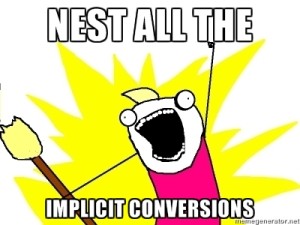Chaining implicit conversion in scala
Today I was hanging in the #scala IRC channel and somebody came along(forgot the nick, sorry) and asked about some compilation error. I deduced he was trying to chain implicit conversions. And this doesn’t work. Else compilation would take forever and would also compile some wrong code by inserting long strings of implicits. But then somebody else responded(I think nick started with d) and gave a solution to implicit chaining. But I’m not giving it away yet, you’ll have to read a bit more.
The problem
Let’s say I have some classes that just add semantics to values(think labeled boxes)
| |
And because they look similar we may want to do some implicit conversion. Let’s say that that’s needed is conversion from Bar to Foo and from Baz to Bar.
| |
On a level this also implies that Baz can be seen as Foo. But when you try it
| |
you get a compile error
Implicits.scala:18: error: value a is not a member of Implicits.Baz
println(baz.a)
^
one error found
The solution
As said, scala compiler doesn’t try to traverse the graph of implicit conversions and therefore doesn’t figure out how to insert needed conversions here. But here lies a handy catch. What if the conversion wasn’t from Bar to Foo but from something Bar-like to Foo. Then the compiler would know that this chaining is intended and is (probably) not a dead end. Good news: scala lets you express that. It’s called a view bound. You make the method generic and limit input type to something that can be seen(implicitly converted to) as a Bar. Here’s the code.
| |
All the magic lies in the <% operator. That’s the view bound. When you
type baz.a the compiler sees that a property is available on the Foo
class and that there’s an implicit conversion to Foo from something
Bar-like. Fortunately there’s a conversion from Baz to Bar in scope so
it can invoke the method. Inside the method it tries to get the b
property from baz but it’s not available. So it checks the conversions
and sees that a conversion from Baz to Bar exists in the scope and it
satisfies the need for b. It inserts this conversions and compilation
happily chucks along.

Please don’t do that. Implicits can make code hard to read even without nesting. So use with care. Scala is a very powerful language but great power comes with great responsibility.
Last modified on 2013-01-27
Previous Generic singletons through dependent method typesNext 750 words